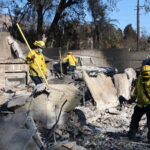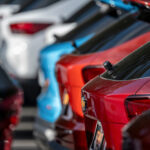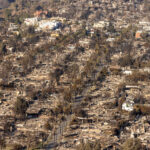For the last decade, engineers specializing in fire safety have worried about the hidden danger posed by the kind of insulated metallic skin that transported flames up a high-rise apartment building in London, killing dozens.
Panels of the armor-like “cladding” have become a popular facade on tall buildings worldwide, both for their sleek look and energy-saving virtues. They also have helped fuel spectacular infernos in the Middle East, Europe, Asia and the United States.
Some fire experts worry that, with energy efficiency a priority worldwide, the proliferation of “green” buildings has the unintended consequence of fanning fire danger. Though cladding can be flame-resistant, the result can be deadly when it is not.
“The good intent of sustainability translates into a potential fire safety problem,” said Brian Meacham, a fire protection engineering professor at Worcester Polytechnic Institute in Massachusetts. His concerns began to crystalize in 2010, he said, when he was in South Korea presenting a paper on new technology and fire safety and a cladded high-rise burned.
At London’s Grenfell Tower, flames raced with alarming speed up 24 stories of cladding in which a plastic core was sandwiched between thin sheets of aluminum. That composite is one of several kinds of exterior paneling that helps moderate inside temperatures, saving on energy needed for heating and cooling.
The tower’s aging concrete facade received the face-lift last year as part of a 10 million pound ($13 million) publicly funded refurbishment effort aimed, in part, at making the building more energy efficient.
The tower, home to as many as 600 people, burned Wednesday. At least 58 people were confirmed or presumed dead, a tally that could rise.
Authorities are still investigating the fire. Its behavior strongly implicated the cladding, several fire safety experts said in interviews. Anger has mounted in the community following reports that contractors had used cheaper panels in which the plastic insulation was not fire-resistant.
Cladding with pure plastic insulation costs less and insulates better than an alternative that incorporates fire-slowing minerals, experts said. On short buildings, it makes sense.
Not so for taller buildings. The International Building Code – a model of construction standards adopted widely in the United States, some areas of the Middle East and the Americas – calls for the use of fire-resistant cores in buildings over 40 feet (12 meters) tall. The code in England is less specific, giving architects latitude in how they make sure exterior insulation is safe as long as “the external walls of the building shall adequately resist the spread of fire.”
Two British government officials – Trade Minister Greg Hands and Treasury chief Philip Hammond – said in separate TV appearances Sunday that the cladding used on Grenfell seems to be prohibited by British regulations. Hands cautioned that officials don’t yet have exact details about the renovation.
Fires fueled by metal composite cladding in the past five years have charred high-rises in France, Dubai and South Korea. A 2007 casino fire in New Jersey was a wake-up call in the United States. Fires in buildings with other types of outer insulation have struck in other places, including Australia and China, where one killed 58 people. Though the fires may not be frequent, their quick spread makes them very dangerous.
To get a green certification, a building must, among other things, be more energy efficient than local codes require. The designation, conferred by private firms for a fee, does not focus on fire safety, referencing instead local code requirements. While the cladding made Grenfell Tower more energy efficient, the building did not reach green certification.
Green building practices may not be “inherently introducing risk, but I think it makes it a lot easier to make mistakes,” said Peter Weismantle, a Chicago-based architect who specializes in “supertall” buildings, including the world’s highest in the United Arab Emirates. He cited factors such as workmanship as well as the improper use of flammable cladding.
The U.S. Green Building Council, which oversees the industry-leading certification known as Leadership in Energy and Environmental Design (LEED), said in a statement to The Associated Press that the Grenfell tragedy holds safety lessons.
“We stand with those who will learn these lessons in honest efforts to advance the aligned goals of life/safety and environmental building performance,” said the statement attributed to Brendan Owens, an engineer and senior vice president at the council. “Compromising life/safety in search of environmental gain is not a choice.”
In 2012, fire safety experts invited green building representatives to a symposium in Chicago. The engineers’ concern was that various green requirements could inadvertently conspire to increase fire danger. Meacham, the Massachusetts professor, addressed the gathering and said he did not sense much interest in fire safety within the green building industry then – or since.
“I think they view it as outside of their agenda,” Meacham said. “I don’t think they’re being necessarily mean about it; I think it’s more ignorance of the issues.”
In some places, the issue is impossible to ignore.
At least 30,000 buildings across the United Arab Emirates alone have cladding or paneling similar to the kind that safety and construction experts have blamed for rapidly spreading high-rise fires there, Dubai Civil Defense director-general Maj. Gen. Rashid Thani al-Matrooshi acknowledged in April 2016.
In January, Dubai authorities announced new fire safety rules, saying existing buildings with questionable cladding would “have to change it” under normal maintenance schedules. But they offered no further information to the public.
(Pritchard reported from Los Angeles. Gregory Katz in London and Rhonda Shafner in New York contributed.)
Was this article valuable?
Here are more articles you may enjoy.

 New Fire Maps Put Nearly 4M Californians in Hazardous Zones
New Fire Maps Put Nearly 4M Californians in Hazardous Zones  Scammers Are Pushing Auto Loan Fraud to Record Levels
Scammers Are Pushing Auto Loan Fraud to Record Levels  Supreme Court Refuses to Revive Youths’ Climate-Change Lawsuit
Supreme Court Refuses to Revive Youths’ Climate-Change Lawsuit  Catastrophe Experts Tap AI to Tackle Soaring Insured Losses
Catastrophe Experts Tap AI to Tackle Soaring Insured Losses 